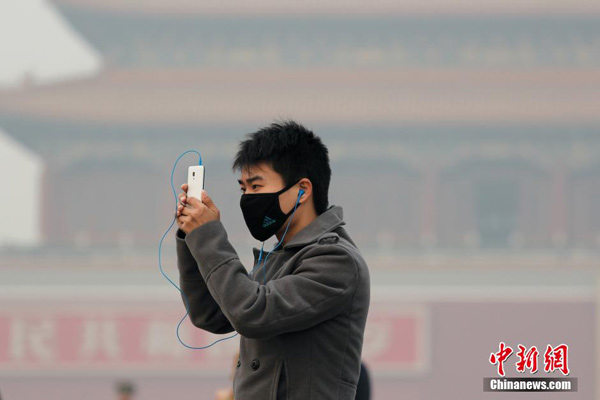


(Photo/CNS)
BEIJING, Feb. 21 -- Beijing is planning to build a web of ventilation corridors to facilitate air flow and blow away smog and pollutants, municipal authorities told Xinhua on Saturday.
The five primary ventilation corridors are designed to be more than 500 meters in width. Some secondary corridors will be over 80 meters wide, said Wang Fei, deputy head of Beijing's urban planning committee.
The corridors will be created by connecting the city's parks, rivers and lakes, highways along with their green belts, as well as low building blocks.
The five major ventilation corridors largely run from the northern suburban areas to the south. One corridor will run through the central axis of Beijing from Taiping Suburban Park in the north, via the Olympic Park, the Temple of Heaven, all the way to the Beijing-Shanghai Highway in the southern end of the city.
In addition to the planned primary and secondary ventilation corridors, other smaller corridors will also be added to the system. Construction in these zones will be strictly controlled, and obstacles along the way will be gradually removed, Wang said.
Some Chinese cities, such as Shanghai and Fuzhou, have been building ventilation corridors to combat air pollution.
"Ventilation corridors can improve wind flow through a city so that wind can blow away heat and pollutants, relieving urban heat island effect and air pollution," Wang added.
Air pollution has become a major concern of residents in Beijing as the city saw the heaviest smogs of years in November and December, 2015, partly due to winter heating. Local residents routinely check air quality and wear masks, and many own air purifiers.
Beijing has taken measures to curb air pollution. In 2015, the city replaced coal fire power plants with cleaner energy, closed or limited the production of more than 2,000 polluting factories. It also initiated its first-ever air pollution red alert mechanism.
Air quality only improved marginally last year in the area around Beijing, data from the Ministry of Environmental Protection (MPE) suggests.
Beijing recorded 186 days of air quality "up to par" in 2015, 14 days more than the year before, according to statistics from the MPE.
The annual average density of PM 2.5 in Beijing, particulate matter that causes hazardous smog, stood at 80.6 micrograms per cubic meter, a year-on-year decrease of 6.2 percent, MEP said.
 2016 Miss Chinatown USA pageant held in San Francisco
2016 Miss Chinatown USA pageant held in San Francisco Ancient pagodas across China
Ancient pagodas across China Beijing Film Academy starts 2016 entrance exam
Beijing Film Academy starts 2016 entrance exam Wedding dress show up in the air
Wedding dress show up in the air Have you ever taken these beautiful subways in China?
Have you ever taken these beautiful subways in China? Russian photographer brings fairytales to life
Russian photographer brings fairytales to life Chinese beauties, foreign models meet in Chengdu
Chinese beauties, foreign models meet in Chengdu Awesome! Aerial pictures taken on J-11 fighter
Awesome! Aerial pictures taken on J-11 fighter A foreign girl explains what China should be proud of
A foreign girl explains what China should be proud of Top 20 hottest women in the world in 2014
Top 20 hottest women in the world in 2014 Top 10 hardest languages to learn
Top 10 hardest languages to learn 10 Chinese female stars with most beautiful faces
10 Chinese female stars with most beautiful faces China’s Top 10 Unique Bridges, Highways and Roads
China’s Top 10 Unique Bridges, Highways and Roads Shooting threat mixes online, offline violence
Shooting threat mixes online, offline violence Chinese peacekeepers face violence, food shortages on UN mission
Chinese peacekeepers face violence, food shortages on UN mission Regulations concerning menstrual pain leave a step in the right direction
Regulations concerning menstrual pain leave a step in the right directionDay|Week